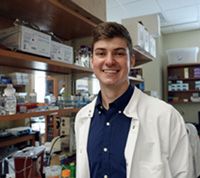Trace Walker’s fascination for science was nurtured in a Florida orange grove. There, he gained an appreciation for the symbiosis between the land and the trees. Now, as a PhD candidate in the Chiappinelli Lab, he researches spatial transcriptomics, the way tumor cells interact and communicate with each other. What goes around, comes around.

What’s your story?
My family moved to Florida from Harrisonburg, VA when I was very young. My grandparents own an orange grove and I grew up surrounded by orange trees. That interaction with agriculture and by extension, biology, fed into my desire to become a scientist.
I went to the University of South Florida in Tampa and studied biomedical sciences and was really interested in medicine. I worked in a research lab that focused on nanoscale technologies and I was fascinated. Nanobots, nanoparticles — it was so cool. I got hooked on research and thought, “This is it. This is what I want to do.”
After I got out of school, I worked in a research lab and built the skills sets that I needed to start grad school and now here I am at GW. I thought about going into an MD MPH program but I realized that I want to focus on the research side of cancer.
I don’t know what’s next. I applied for a grant that would transition me into a post doc position and pursue an academic career. Biotech companies are making strides in the cancer space and that’s really intriguing. I’m very interested in computational biology — performing sequencing analysis to generate really, really large data sets that we use as statistical models to learn more about tumor cell profiles.
What gets you out of bed in the morning?
The first thing that gets me out of bed is my German shepherd, Strudel.
I’m motivated by the pursuit of the unknown. I’ve always wanted to makes sense of what doesn’t make sense to me. I’m always asking why, why, why? It’s what I think about when I get up and I’m getting ready. Coming to work and figuring out something that nobody else has figured out in ovarian cancer (that’s the area our lab focuses on) is really exciting.
What is that one book that has influenced you the most?
It’s hard to pick just one. I read a lot as a kid, and then there was a gap. I’ve started reading again this year, which has been refreshing. I read The Chronicles of Narnia as a child and they’ve stuck with me through adulthood. They shaped my imagination and the creativity I bring to science, which is beneficial. We have to be very analytical as scientists, but bringing creativity and imagination to the lab table can drive some of the questions I’ve been asking and those books built the foundation.
From a professional standpoint, the book that stands out is Lab Girl by Hope Jahren. It chronicles the academic career of a plant biologist. It takes a very realistic look at research, and the trials and tribulations of pursuing an academic career. What I really appreciated about this book was how, as a plant biologist, the author knows she’s planting trees that won’t generate data for 50, 60, 70 years. It’s such an interesting perspective — she knows she won’t answer the questions, but someone else will be able to pick up what she started and do something with her work. It’s a great way to approach research: I am not going to solve this problem by myself, but what I do today will impact researchers who come after me.
What absolutely excites you right now about research and advances in cancer treatment?
I’m really interested in spatial transcriptomics. It’s a technique that studies how cells communicate with each other, how diseases like cancer spread, and how different parts of a tissue or organ function together. It combines traditional gene expression analysis with advanced imaging to map out where specific genes are active in a tissue sample. By seeing both the gene activity and spatial arrangement of cells, scientists can gain deeper insights into these processes and develop more targeted treatments.
What is the most interesting thing we should know about you?
As I said, my family has an orange grove, and growing up there was really cool. I learned what goes into agriculture; how the land and health of the trees are maintained; how the citrus is processed. It taught me that I didn’t want to do that kind of manual labor. It’s tough work, and it made me appreciate the people who do that for a living.
I feel a sense of responsibility for the land. As a small child, I played in the grove. As a teenager, I worked the land and learned how to take care of the trees. As an adult, I feel this responsibility of wanting them to be healthy and help them grow. And there’s a sense of calmness when I’m there — the smell of the earth, the fragrance of the blossoms, the steadfastness of the trees — it’s such a connection to nature, to home.



